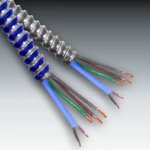In some case, like with Lutron products, you can change the Class 2 to Class 1 and use the same raceway or cable for power and control.
I spent a ton of hours with Lutron and Code gurus where I had a similar concern.
Even to this day I can't say I have a thorough picture but, in my case we looked at
Exception 2 to 725.130 which allows us to classify the Class 2 circuits as Class 1 and 725.48 allows Class1 circuits to share a raceway or cable where the equipment is functionally associated, but that doesn't help when your LV wiring method is a Class 2 cable.
In addition, on my installation the cables were sharing the same j box and the lighting circuit was 277v eliminating our using 725.136(D).
I find Paul's cable in Post 4 to be very interesting. I'm unsure how to address that in a j box and perhaps he can help us with that.
I was faced with a load of fixtures that had a mutliwire pendant type cord to supply power and Lutron diming controls. The E/C needed to use that cord. The only solution I forund was to install the Lutron wiring as Class 1 but someone here may show us another solution.



